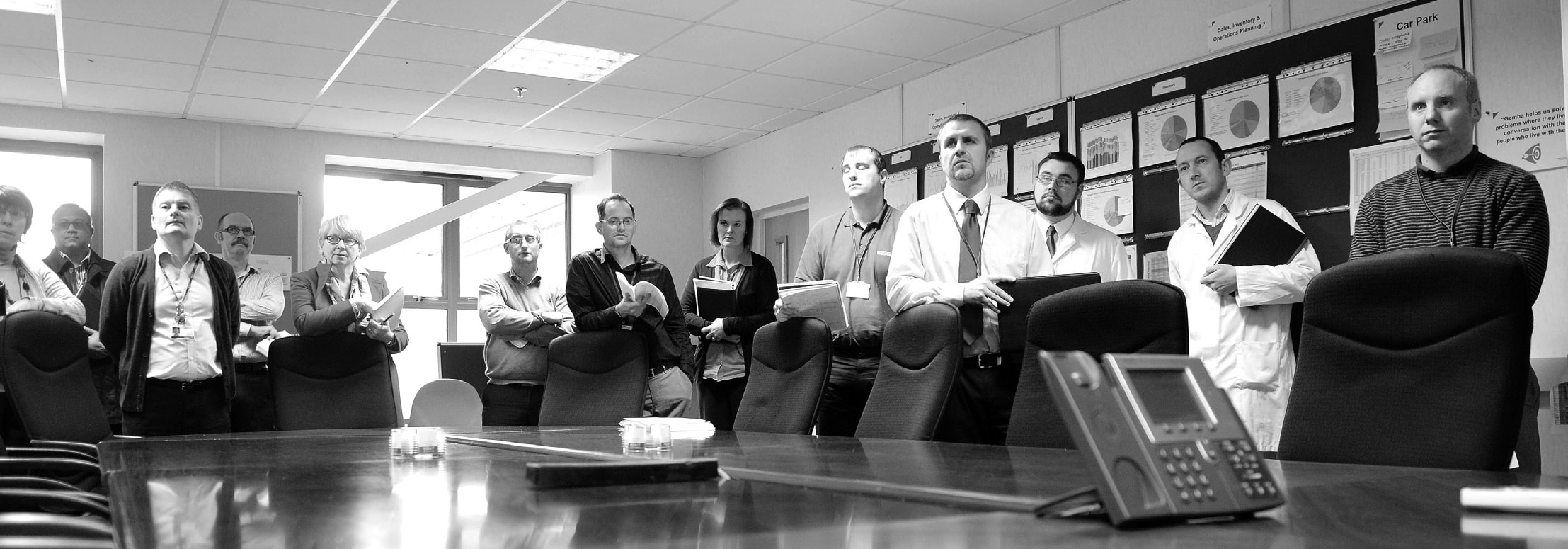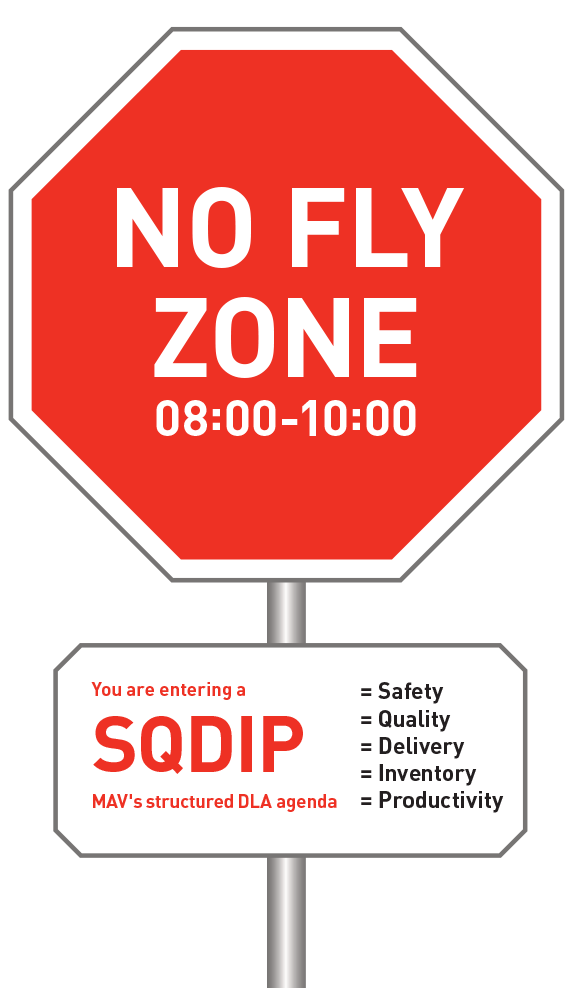
Above: Focus Factory: when MAV’s 20 or so functional leaders gather each day to discuss all issues arising from the morning’s Daily Layered Accountability meetings, which start on the shop floor. Attendance is compulsory.
Silo-busting in DLA's no-fly-zone
The spinal cord of MPS is DLA, or Daily Layered Accountability. This multi-layered structure of interlocking meetings right at the start of each working day flows fresh, accurate performance and operational information up and down the business. From 8am and for two hours only DLA meetings must take place. This is the so-called ‘no-fly zone’. Each meeting follows an agenda structured around safety, quality, delivery, inventory and productivity. Attendance is compulsory.
This is our first glimpse of the cross-functional, silo-busting power of DLA

DLA starts on the factory floor. At 8am production cell teams review the previous day’s performance and plan the day ahead. Immediately afterwards, cell leaders and representatives from the functions perform a similar review but at the value stream level. Finally, the whole plant’s performance is reviewed by senior management at Focus Factory. OPEX recently visited Meggitt Avionics one morning to watch DLA unfold.
07:59
A cell team is gathering in front of a DLA board positioned prominently in their work area. The whiteboard’s graphs and charts provide an at-a-glance summary of everything the cell needs to know about its current performance and problems. Red blocks, bars and lines reveal opportunities to improve. Green says things are ‘on track’. Ten or so people watch the clock and wait. Most wear white lab coats or the blue of the engineering shop and have safety glasses perched on their noses.
Because Meggitt Avionics is a self-contained business, all its functions, including sales and marketing, procurement and HR, are simultaneously running similar meetings, using similar tools.
08:00
At 08.00 sharp Sean Holland starts. The events of yesterday are reviewed and the needs of the day(s) ahead considered. Prescription safety glasses are on their way—recently installed benches aren’t bright enough— new components have increased rework. Are altered procedures for selecting fasteners hurting overall productivity? Does a casing edge need redesigning to speed assembly? Problems are logged, countermeasures and responsibilities for them allocated. Anything the cell cannot solve for itself is flowed up to the value stream meeting which will start nearby just minutes after this one ends.
08:11
Finished. The whole meeting lasted barely 10 minutes.
08:20
While everyone else returns to their benches, new-build value stream (VS) attendees begin to assemble. Cell leaders and function representatives from the Production Engineering Department (PED), Procurement, Quality and Continuous Improvement gather in front of an electronic board. This is our first glimpse of the cross-functional, silo-busting power of DLA. Everyone has one eye on the digital clock in the corner of the large interactive whiteboard. A colour-coded, multi-layered spreadsheet fills the rest of the space.
08:30
On the dot of eight-thirty Lee Barnes, standing in for Dean Ridley, takes a deep breath. Safety. Quality. Inventory. Delivery. Productivity. In a blizzard of acronyms and code numbers the meeting marches smartly on. Reports are concise. What’s on time, what’s delayed? Parts and materials incoming. Product outgoing. Questions are few. Answers are ready. Decisions are taken briskly.
08:42
After just 12 minutes the meeting is over and we are on our way to Focus Factory, the plant-level review.
08:50
The OER (or operations excellence room) is dedicated to the Focus Factory stand-up meeting. Its walls are almost completely covered with graphs and charts, many of them updated early this morning. This is ‘the big picture’—the current state of play across the whole operation. The information on these walls is permanently on display and can be viewed by anyone at any time. No one manager ‘owns’ it. It belongs to everyone. In April many of the graphs and charts carried yellow stickies to highlight problems with the data or the processes that generated them. Six months on there are very few, if any, to be seen.
08:57
Three minutes to kick-off. The twenty or so Focus Factory attendees include: all value stream leaders; site function leaders from HR, Sales, Procurement, Commercial, Finance, Materials, Production, Engineering, Compliance, Production Engineering and Repairs; and the site leadership council led by Annette Hobhouse and Mark Crompton. All are waiting for the off.
09:00
Safety? “It’s a green day.” Quality? “Green as well—the missing O-ring is due later today—CAA visit—daily quality clinics working—corrective actions overdue?” Delivery? “Shipped close to a million—five-point-five million in plan—approval to ship to customer now letter of credit received—couple of things that could go into arrears—risk on AMOS vessels still—HIADC refresh delay? Signed contract from customer due this week—ISFD? All done. Tremendous effort, amazing achievement, let’s celebrate!” Inventory? “Green!” Productivity? “Key issue is ISFD—root cause—actions—rework—resource limit.” Any other business?
09:09
The main meeting ends with Annette Hobhouse’s warm thanks for everyone’s hard work at last weekend’s open day. As people drift away to their desks several micro-meetings break out spontaneously. ■
